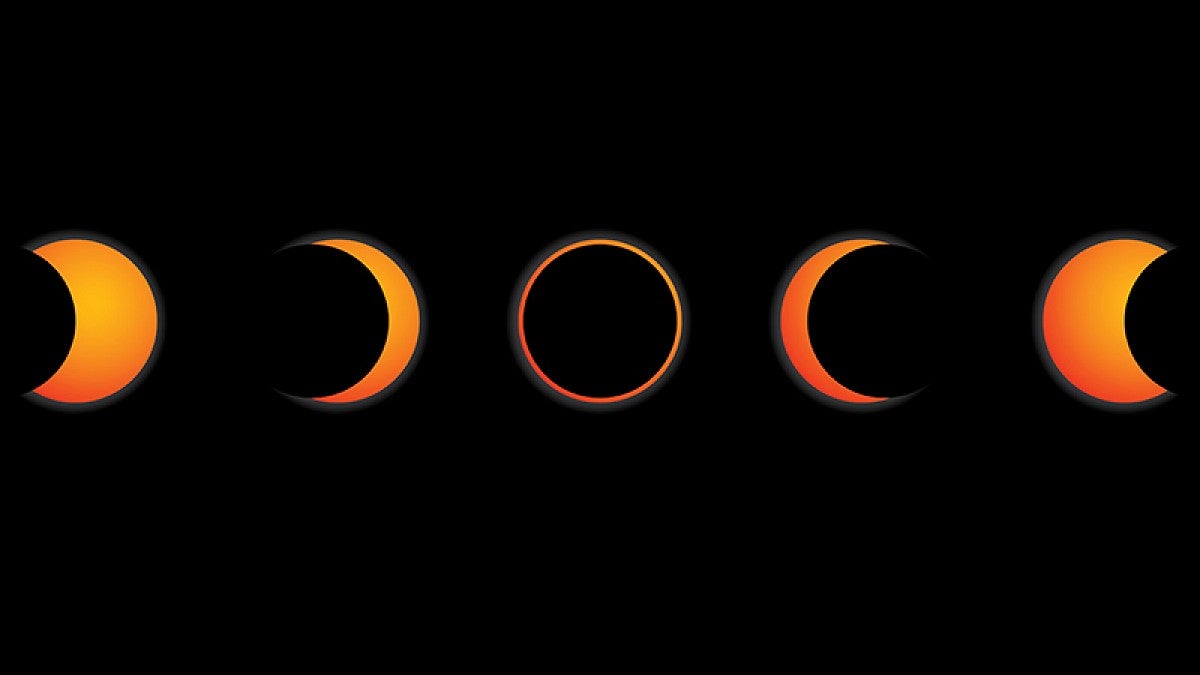On the morning of Saturday, Oct. 14, Ducks in Eugene will be able to look skyward and see an unusual astronomical phenomenon.
Beginning just after 8 a.m., the moon will slowly pass between the sun and the earth. And for a few minutes starting at 9:16 a.m., it will almost overlap with the sun in the sky, leaving a glowing “ring of fire” around the dark void of the moon.
Oregonians are well-positioned to watch the action of this annular solar eclipse.
What’s an annular eclipse? How is it different than the 2017 solar eclipse?
The 2017 eclipse was a total eclipse. In the path of totality — which passed over Oregon, though it just missed Eugene — the moon moved between the Earth and the sun and fully blocked the sun’s light. People watching it could, for a few minutes, safely remove their eclipse glasses and look directly at the sun.
Total eclipses are particularly exciting to astronomers because they offer a rare chance to see and measure features of the sun that are usually hidden. In particular, the corona, the outermost layer of the sun’s atmosphere, is usually washed out by the bright glow of the sun.
“The total eclipses are the prima donnas, the full exhibition, because you have the full disc of the sun covered; it's the only time we can see the corona of the sun with our eyes,” said Scott Fisher, director of the UO’s Pine Mountain Observatory. “The annular eclipse is a different flavor of eclipse.”
On Oct. 14, the moon will slide in front of the sun. But because of its position in its orbit, it will be too small this time to fully block out the sun. Instead, at the peak of the eclipse, viewers will see a thin, glowing ring of the sun around the moon.
Even though 95 percent of the sun will be covered at the peak, the sun will still be too bright to view safely without eclipse glasses. So, keep your eye protection on the whole time, Fisher emphasizes.
Where can I watch the annular eclipse?
Assuming the skies are clear Oct. 14, people in Eugene should be able to step outside and watch it “anywhere you can see the morning sun; you don't have to go to a special spot,” Fisher said.
Meanwhile, Ducks in Portland will get a partial show. The moon will still move in front of the sun, but it will never fully overlap to form a ring.
Committed eclipse viewers who are concerned about the weather might consider heading to the east side of the Cascades, where skies are more likely to be clear. The annular eclipse will cut a swath some 130 miles wide across southeastern Oregon, passing over communities like La Pine and Fort Rock, as well as Crater Lake National Park. The Pine Mountain Observatory is just outside this zone, Fisher said.
Where can I get eclipse glasses?
Any eclipse glasses you buy should meet the ISO 12312-2 safety standard and should clearly say so on the glasses. That said, counterfeit glasses were an issue during the 2017 eclipse, so Fisher recommends buying from a vetted online source, like Lunt Solar Systems, rather than Amazon. The American Astronomical Society has a list of trusted sources, too.
If you’ve stashed away your glasses from the 2017 eclipse, they might still be usable as long as they aren’t scratched or torn. As long as you bought them from a reputable vendor that meets the modern international safety standards, eclipse glasses no longer expire, according to NASA.
But if you’re worried, it’s better to be safe than sorry when staring directly at the sun. New glasses will cost you just a few dollars.
When will I get another chance to see an eclipse?
A total solar eclipse will cross the United States on April 8, 2024, but Oregonians will only see a partial eclipse. After that, the United States won’t see another total eclipse until 2044. And the next annular eclipse visible in Oregon won’t happen until 2046.
“Oregon is quite lucky, getting a total eclipse and an annular eclipse within a few years of each other,” Fisher said.
—By Laurel Hamers, University Communications

